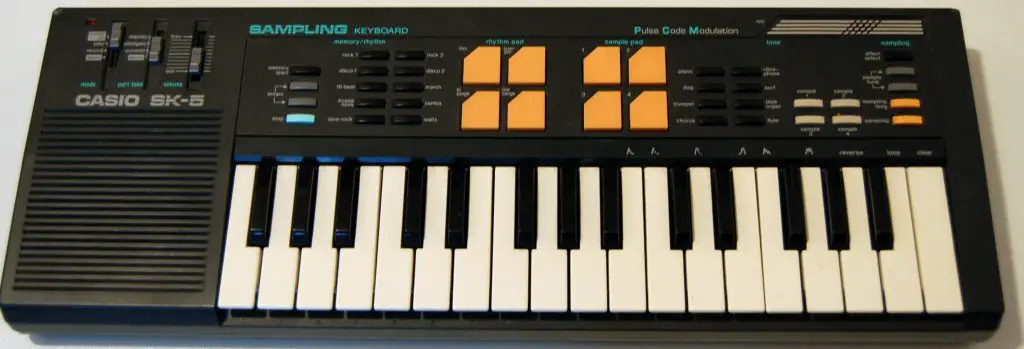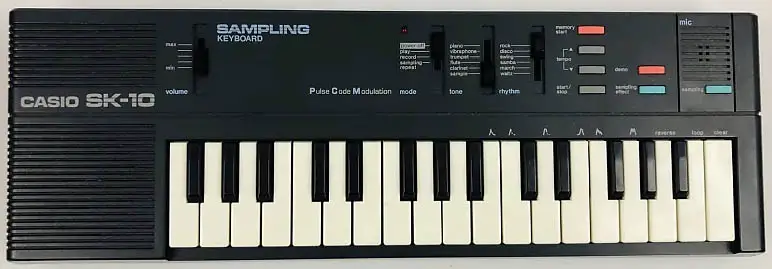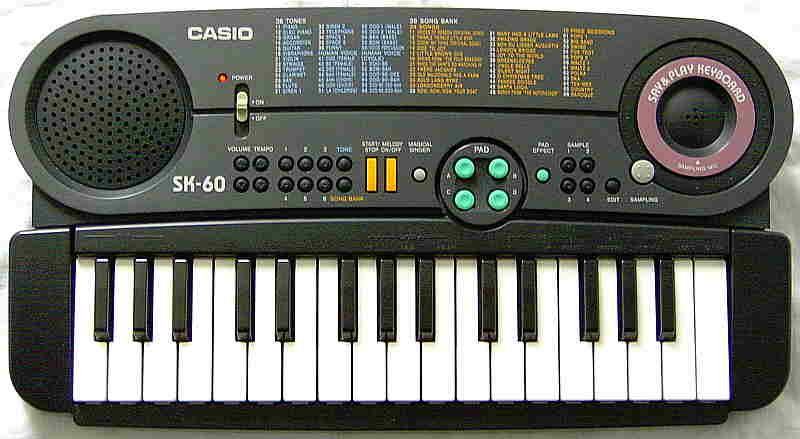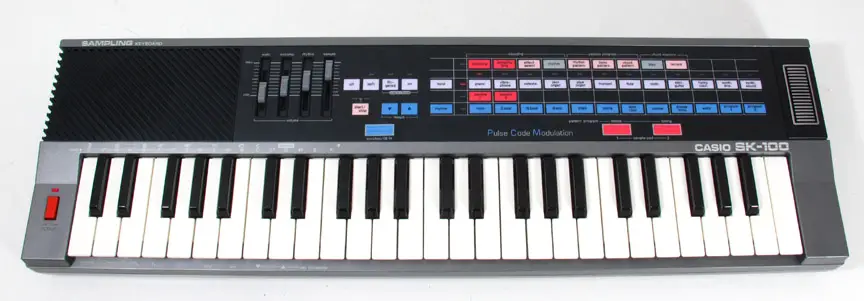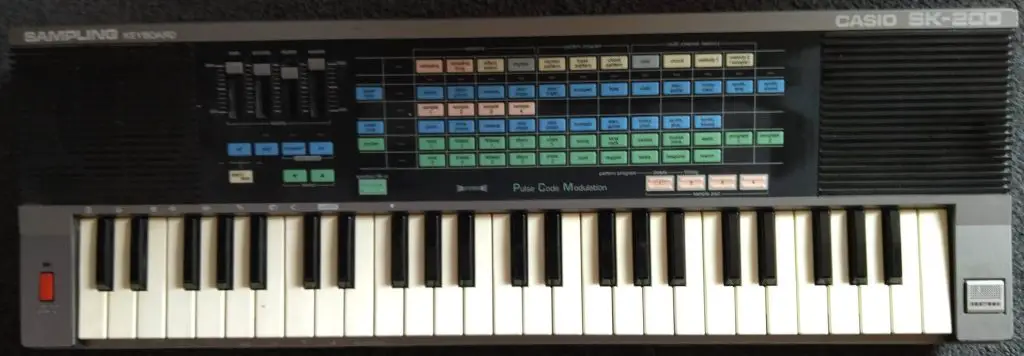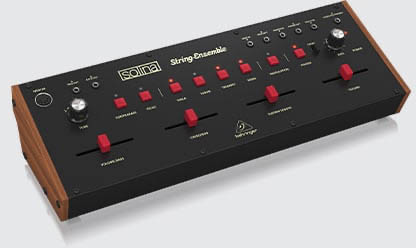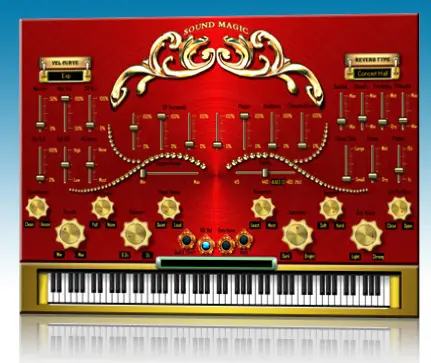Introduction
In the 1980s Casio produced a number of small, budget keyboards capable of recording sound samples and allowing the user limited manipulation over those sounds, as well as providing other basic functionality we had come to expect from digital musical instruments of the decade. Here we take a nostalgic look at them.
Contents
- Models Overview
- Resources
Casio SK Models Overview
There were ten models in the SK (sampling keyboard) range manufactured by Casio in the mid to late 1980s, most having mini or “petite” 32 or 49 key keyboards, battery operated, with the ability to record very basic sound samples via inbuilt microphone or (sometimes) audio jack input.
They were generally cheap but were popular with some musicians, DJs and enthusiasts looking for easy ways to sample sounds. Their popularity has increased again in recent times, as with a number of other low-budget digital instruments of this period, due to nostalgia, and for those seeking authentic lo-fi digital sounds.
They are also prime candidates for circuit bending.
The ten models released are:
- SK-1
- SK-2
- SK-5
- SK-8
- SK-8A
- SK-10
- SK-60
- SK-100
- SK-200
- SK-2100
Casio SK Models Focus
Casio SK-1

Launched: 1985.
Although the SK-1 could be considered a ‘joke’ or simply a toy, it has gained a rather cult following and has been used by professional musicians and those interested in circuit bending.
It features 32 mini keys, four note polyphony, 8-bit PCM sampling of up to 1.4 seconds, built in microphone and line level/mic inputs, internal speaker and line out. This means it can be used successfully as part of an audio chain (no MIDI). As well as the sampling ability there are a few built-in instrument voices.
All voices can be shaped by 13 present envelopes, portamento and vibrato, and there’s a basic sequence recorder, rhythms and chord accompaniment. Given it retailed for under $100 when it was launched, it’s actually a pretty decent lo-fi (by today’s standards) instrument, and worth of experimentation.
And talking of experimentation, plenty of people have circuit bent the SK-1 as it can run off batteries, has simple internals, and is a decent instrument to work with.
Musicians who have used the SK-1 include Fatboy Slim, Beck, Autechre, Portishead, Bloodhound Gang, Nine Inch Nails, Incubus and Blur.
Ironically, this cult status means the prices for obtaining a working SK-1 can now be considerably higher than their original price.
Casio SK-2
Launched: ?
Despite the higher model number, the SK-2 looks to have fewer functions than the SK-1. It has 32 mini keys and uses the same sound technology (8-bit PCM), is four note polyphonic, has five preset tones (piano, vibraphone, trumpet, flute, clarinet) plus pipe organ as a default sample sound. Six auto-rhythms.
It has a 496 step real-time memory. Sampling rate of 9.38kHz and sampling time of 0.6s, which is about half of the SK-1. Effects are envelope, reverse and loop, with 16 pattern repeat.
Although the unit can be run from batteries or power pack, there is no other input or output jacks, making it far less versatile for use in music setups than the SK-1. It’s a shame as you only get to use the built-in mic for getting sound in, although I expect someone could hack the internals if they wanted sound input and output.
Casio SK-5
Launched: 1987
The Casio SK-5 seems to share many of the features of the SK-1 but has an updated front panel which includes drum pads, plus extra sample areas. It still has the 32 mini keys, four note polyphony, 8 sounds and 10 rhythms. It seems as if up to 1.4 seconds of samples can be used but it depends how many of the four sample areas are used. Of course having four different sample areas (even for very short sounds) does increase its potential somewhat, especially as they can be played back on the pads.
There is an audio output jack but sadly, no obvious audio input jack, meaning you’re relying again on the internal microphone for sound acquisition.
Casio SK-8
Launched: 1987
The Casio SK-8 is very similar to the SK-5 except it also has the ability to play Casio ROM Packs. It has the same sampling restrictions as the SK-5. The four sample pads remain though the rhythm drum pads have gone. The audio input and output jacks have returned, for better sampling and sound capture. The keyboard also has melody lights above each key, which will light when playing back music from the ROM Packs, and can aid in learning songs.
Casio SK-8A
Launched: 1987
This was a regional variant of the SK-8, apparently designed for the Arabic market. The only noticeable difference is the addition of a “scale” slider which permits “normal” (ie Western) scale, Arabic scale, and two other modes which seem to allow the setting of quarter tones on specific notes. Not sure exactly how this works but definitely a basic system for utilising alternative tunings.
Apparently there is an “Easter egg” on the SK-8 which allows it to have this function, suggesting that the SK-8 and SK-8A are basically the same machine but with a couple of extra interface switches.
Casio SK-10
Launched: ?
The SK-10 is a reduced function version of the SK-1, so it has many of the same abilities including 1.4s of 8-bit PCM sampling (one sample only), 32 mini keys, 13 envelopes, portamento, vibrato, five PCM tones, 11 drum patterns, three synth tones. It also has basic step and chord programming on board.
It’s difficult to get detailed information on this keyboard except to see that those who rate the SK-1 think this is a very poor imitation, and not worth bothering with.
Casio SK-60
Launched: 1995
Launched a decade after the SK-1, it’s clear the technology available to low end keyboards has improved, as we can see from the specifications of the SK-60. It still has the 32 mini keys and its polyphony has jumped to 12 notes. Added to this are 36 onboard sounds, 12 rhythms and 24 songs.
The sampling rate has increased as has the duration (up to 2.4s depending on how many samples are used). The sampling method is Differential Pulse Coded Modulation (DPCM). The sample features don’t appear to be as advanced as the SK-1, though, with only loop, reverse and release effects, and there are no audio inputs or outputs so you are stuck with the built-in mic and speakers.
It also has a Magical Singer mode where all parts of the playback can be changed to human voice tones.
The overall look of the keyboard is a bit more curvy that its predecessors, and it has a “Say and Play” tagline which basically describes how a sampling keyboard works! The pads are tiny compared to previous models which had them.
Casio SK-100
Launched: ?
The Casio SK-100 is the first of this range to increase the number of keys from 32 to 49 mini sized keys, making it a four octave instrument. It has eight notes of polyphony, 12 sounds, a chord accompaniment system, and pattern memory.
Its sampling capabilities are not as advanced as the SK-1 although it has a better sampling frequency and can take two samples. It does have line out and in jacks so you can sample from connected equipment and also send the audio output to other devices. Sampling features are minimal.
Casio SK-200
Launched: 1987
An earlier model again, despite the number, but one which delivers a four octave spread of keys and provides a bit of an update to the SK-1, although that does appear to have more sampling manipulation abilities.
The SK-200 was clearly designed by someone infatuated with buttons, which you use for the rhythm and sound selections. There is an audio in and out as well as the built-in mic, again making for better quality sound capture and sends. Sampling quality isn’t that much improved, though at the time it was a great, and cheap, option for certain kinds of music.
The keyboard lets you build up your own rhythms, has four sample slots, is 8 note polyphonic (only three for samples), and can be used as rudimentary sequencer.
Casio SK-2100
Launched: 1987
The Casio SK-2100 is the only model in the SK family of sampling keyboards to feature full size keys, 49 of them. You still don’t get velocity sensitivity on any of the keys or pads, but it’s fair to say this is a bit of a ‘grown up’ SK-1 with many of the same functions but with more adult-friendly keys (perhaps ironic given this is still regarded as a toy and mainly aimed at kids).
So much of the same remains, a relatively low sampling frequency, mainly decent but not superb onboard sounds and rhythms, four samples and various preset manipulations, mic, line in and audio out.
The SK-2100 comes with an attached microphone rather than one built in to the front panel. It comes out from the top right of the panel and is attached with curly “telephone” wire. The quality is poor but it’s something to get started with at least.
It seems as if this was meant to be a slightly higher-end keyboard from Casio, within the bounds of this class of instrument at least.
Resources
Here are some resources we have found concerning the Casio SK series of keyboards. This includes links to further information and some videos.

